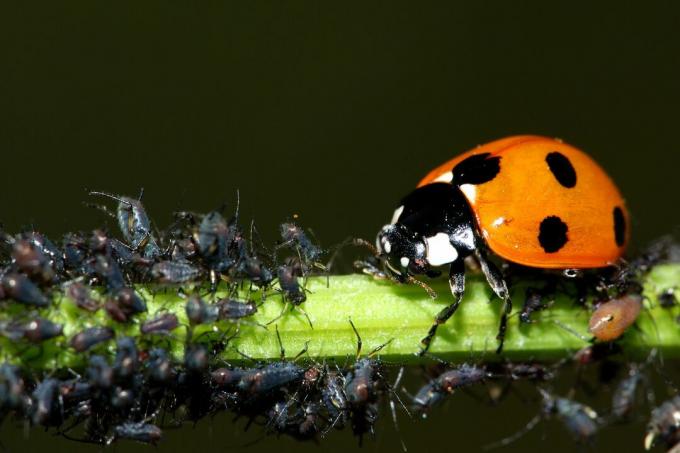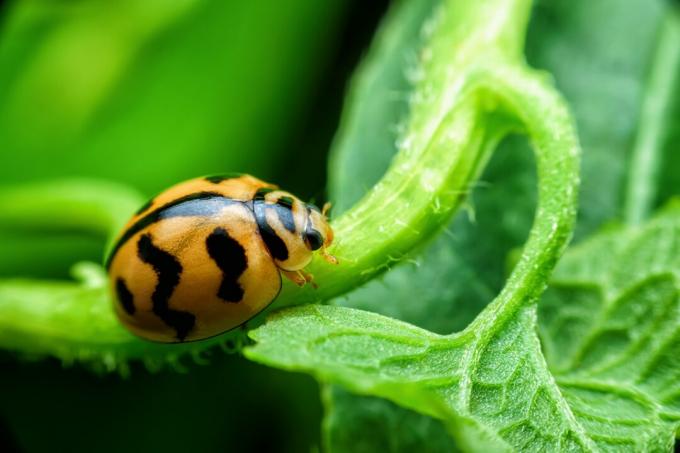Not only children find ladybugs great, adult gardeners are also happy about the small insects. Here are seven facts about the beneficial insect.

It can be found in almost every garden and often excites children: the ladybug (Coccinellidae) is probably one of the most popular insects ever. No wonder, after all, it not only scores with its unusual coloring, but can also be quite useful in the garden.
But have you ever asked yourself why the ladybug is a lucky charm or how old such an animal can get? We have put together seven interesting and useful facts about the ladybug for you.
1. Beneficial organism ...
Of course, the ladybird is known to all gardeners as a beneficial insect. In fact, the ladybug doesn't just eat Aphids, but also Spider mites, Bed bugs, Fringed winged beetles and sawfly larvae. If there is a shortage of food, some species of ladybirds have a very special tactic: They simply switch their food to pollen and fruit until there is enough other food again. But there are also types of ladybirds that feed entirely on plants.

2.... or a pest?
Unfortunately, ladybugs don't always bring good luck. In fact, the insects can actually be real pests. The twenty-four spotted ladybird, one of the three herbivorous species in Europe, is particularly harmful in warmer countries. He mainly nibbles on alfalfa and sugar beet, but also on cloves and Dahlias. Fortunately, in Germany the ladybird only causes damage in exceptional cases.
3. The ladybug as a lucky charm
Have you ever wondered where the ladybug got its name from? In fact, this goes back to Mary, the Mother of God. Since the ladybirds were already known as pest killers in the Middle Ages, the farmers believed that it must be a gift from the Virgin Mary. At the same time, the ladybird developed into a symbol of luck: if you had a lot of ladybugs in the field, you didn't have to worry that the harvest would be destroyed by aphids.

4. Bad smell
When the ladybug feels threatened, one has a very special way of defending itself: namely, it can secrete a yellowish secretion from its joint membranes. This has a particularly unpleasant odor that is said to drive away predators. In addition, this secretion even contains poisonous alkaloids. In addition, the ladybug tastes extremely bitter - that makes it unattractive, even for wolverines.
5. Read the age from the dots
As a child, who hasn't counted ladybirds' dots to find out how old the little animals are? Unfortunately, this myth is wrong: the number of points does not reflect the lifespan of the beetle. In fact, most ladybugs only live to be around a year old. Nevertheless, the points are not counted for free - the number and arrangement of the points can be used to distinguish the different species of ladybirds very well.
6. Dotted, striped or just plain?
When we think of a ladybug, of course, we immediately see a red beetle with black spots in front of our inner eye. But not only the number of dots can vary - the ladybirds come in a wide variety of different colors and patterns.

Some species are monochrome without dots and can be colored from light beige or yellow to brown or black in all colors. Our domestic two-point ladybirds not only have red beetles with black spots, but also black beetles with red spots. Some ladybugs are even striped.
7. A garden for ladybugs
Luckily, luring ladybugs into the garden is quite simple: since the ladybirds' favorite food is aphids, that's enough It is often enough to do without chemical pesticides - the small beneficial insects then take care of them Rest. A near-natural garden with a pile of leaves also gives the little insects joy, because they can be perfectly overwintered in this. If you also offer the animals a wide range of flowering plants throughout the year - for example with the Plantura beneficial insect magnet -, ladybugs feel good all around.
If you want to find out more about domestic garden animals, then take a look at our article Bumblebees past.
